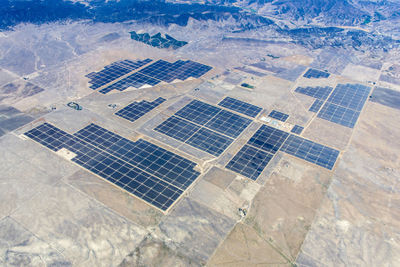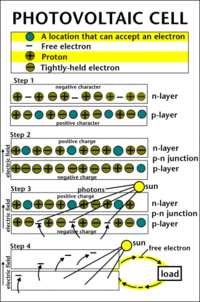Difference between revisions of "Solar Farms in the California Central Coast Region"
(→Photovoltaic technology) |
(→Fixed arrays) |
||
| Line 14: | Line 14: | ||
===Array Design=== | ===Array Design=== | ||
====Fixed arrays==== | ====Fixed arrays==== | ||
| − | Fixed arrays are the simplest and most affordable design<ref>[http://www.solarpaneltilt.com/ Solar Panel Tilt]</ref> | + | Fixed arrays are the simplest and most affordable design.<ref>[http://www.solarpaneltilt.com/ Solar Panel Tilt]</ref> These arrays are simply anchored on the ground or surface and remain stationary. |
<br><br> | <br><br> | ||
| − | While more affordable, fixed arrays are subject to fluctuations in energy output throughout the day and year. Energy output is maximized when the sun's rays strike the arrays at a perpendicular angle. Since the angle between the arrays and sun changes daily and seasonally, the energy output of fixed arrays is frequently sub-optimal<ref>[https://cedco-op.com/2016/07/27/solar-power-fixed-arrays-vs-trackers/ Community energy development co-operative]</ref> | + | While more affordable, fixed arrays are subject to fluctuations in energy output throughout the day and year. Energy output is maximized when the sun's rays strike the arrays at a perpendicular angle. Since the angle between the arrays and sun changes daily and seasonally, the energy output of fixed arrays is frequently sub-optimal.<ref>[https://cedco-op.com/2016/07/27/solar-power-fixed-arrays-vs-trackers/ Community energy development co-operative]</ref> |
| + | |||
====Solar trackers==== | ====Solar trackers==== | ||
Revision as of 23:50, 5 April 2017

This page discusses solar farms in the central coast region.
Contents
Summary
Technology and design

Photovoltaic technology
Solar panels or arrays that converts solar energy directly into electricity implement photovoltaic (PV) technology.
Within each solar panel and array are small units of semiconductor material called PV cells. When sunlight strikes the surface of a PV cell, some photons are absorbed by the semiconductor material.[1] The photons transfer energy into the atoms of the semiconductor material and triggers the release of electrons.[2] These electrons move to the front surface of the PV cell and create an electrical imbalance, with the surface having a more negative charge than the bottom. The imbalance results in a voltage potential similar to the positive and negative ends of a battery.[3] Connecting electrical conductors to the positive and sides of the PV cell creates an electric current and generates electricity.[4]
All existing and proposed solar farms in the central coast use or plant to implement PV technology.
Array Design
Fixed arrays
Fixed arrays are the simplest and most affordable design.[5] These arrays are simply anchored on the ground or surface and remain stationary.
While more affordable, fixed arrays are subject to fluctuations in energy output throughout the day and year. Energy output is maximized when the sun's rays strike the arrays at a perpendicular angle. Since the angle between the arrays and sun changes daily and seasonally, the energy output of fixed arrays is frequently sub-optimal.[6]
Solar trackers
Ground mounting
Locations in the Central Coast Region
Existing
| Name | Location | Acres | Capacity | Developer | Technology | Equivalent # of homes powered |
|---|---|---|---|---|---|---|
| row 1, cell 1 | row 1, cell 2 | row 1, cell 3 | row 1, cell 4 | row 1, cell 5 | row 1, cell 6 | row 1, cell 7 |
| row 2, cell 1 | row 2, cell 2 | row 2, cell 3 | row 2, cell 4 | row 2, cell 5 | row 2, cell 6 | row 2, cell 7 |
| row 3, cell 1 | row 3, cell 2 | row 3, cell 3 | row 3, cell 4 | row 3, cell 5 | row 2, cell 6 | row 2, cell 7 |
| row 4, cell 1 | row 2, cell 2 | row 2, cell 3 | row 2, cell 4 | row 2, cell 5 | row 2, cell 6 | row 2, cell 7 |
| row 5, cell 1 | row 2, cell 2 | row 2, cell 3 | row 2, cell 4 | row 2, cell 5 | row 2, cell 6 | row 2, cell 7 |
| row 6, cell 1 | row 2, cell 2 | row 2, cell 3 | row 2, cell 4 | row 2, cell 5 | row 2, cell 6 | row 2, cell 7 |
| row 7, cell 1 | row 2, cell 2 | row 2, cell 3 | row 2, cell 4 | row 2, cell 5 | row 2, cell 6 | row 2, cell 7 |
Proposed
Impacts
Economic
Scenic
Environmental Concerns
Endangered and threatened wildlife
Land Development
References
- ↑ U.S. Energy Information Administration
- ↑ Alternate Energy Tutorials
- ↑ U.S. Energy Information Administration
- ↑ NASA
- ↑ Solar Panel Tilt
- ↑ Community energy development co-operative
Links
Disclaimer
This page may contain student work completed as part of assigned coursework. It may not be accurate. It does not necessary reflect the opinion or policy of [CSUMB], its staff, or students.